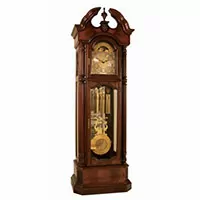How to Care for Your Sligh Grandfather Clock

Sligh Grandfather Clocks are elegant timepieces that add sophistication to any room. Their intricate designs and precision movements make them both beautiful and delicate. Proper care is essential to maintain their function and appearance. Here’s a step-by-step guide to ensure your Sligh Grandfather Clock remains in pristine condition for years to come.
1. Positioning Your Sligh Clock
The placement of your grandfather clock affects its performance and longevity. Choose a stable, level surface away from direct sunlight and extreme temperature changes. Avoid placing the clock near windows or heating vents, as fluctuations in temperature and humidity can cause the wood to warp and the movement to malfunction.
- Tip: Use a mechanical clock bubble level to ensure the clock is perfectly upright. This tool helps maintain accurate timekeeping and prevents unnecessary strain on the movement.
2. Regular Cleaning
Dust and dirt can accumulate on both the exterior and interior of your Sligh clock. Regular cleaning helps preserve its beauty and functionality.
Exterior Cleaning:
- Use a soft, lint-free cloth to dust the clock case weekly. Avoid using chemical cleaners or polish as they can damage the wood finish.
- For intricate carvings or detailed designs, use a soft brush to gently remove dust.
Interior Cleaning:
- Open the clock case periodically to dust the interior components. A small, soft brush works well for this task.
- Never attempt to clean the clock movement yourself, as improper handling can cause damage. If the movement requires cleaning, seek professional assistance.
3. Oiling the Clock Movement
Oiling is crucial to keep the clock’s movement running smoothly. Over time, the movement's gears and pivots can dry out, leading to friction and wear. Sligh clocks typically need oiling every 2-3 years, depending on the environment and usage.

Step-by-Step Oiling Instructions:
- Gather Supplies: You’ll need a clock oiling kit with a needle pen oiler designed for precision application. Make sure the oil is specifically formulated for clocks.
- Access the Movement: Carefully open the clock's access panel. You may need to remove the pendulum and weights to reach the movement.
- Apply the Oil: Using the needle pen oiler, apply a small drop of oil to each pivot point. Avoid over-oiling, as excess oil can attract dust and cause buildup.
- Reassemble the Clock: Replace the pendulum and weights, then close the access panel. Ensure everything is secure before starting the clock.
4. Adjusting the Time and Chimes
To maintain accurate timekeeping and chiming, occasional adjustments are necessary. Here’s how to properly set the time and chimes on your Sligh Grandfather Clock.
Setting the Time:
- To move the hands forward, use only the minute hand. Never move the hour hand directly.
- Slowly turn the minute hand clockwise to set the correct time. If your clock chimes, allow it to complete the chime cycle before moving the hand again.
Adjusting the Chimes:
- If the clock chimes out of sequence, adjust the chime lever inside the clock case. Most Sligh clocks have a chime selector that allows you to choose different melodies.
- Ensure the chime lever is set to the correct position. If the chimes are still not functioning correctly, a professional inspection may be necessary.
5. Winding the Clock
Sligh Grandfather Clocks require regular winding to keep running. Most models need winding once a week. Use the crank that comes with the clock to wind the weights.
Winding Instructions:
- Insert the crank into the winding arbor.
- Turn the crank slowly and steadily until the weight reaches the top. Do not overwind, as this can damage the clock's mechanism.
- Repeat the process for each weight. Sligh clocks typically have three weights—one for timekeeping, one for chimes, and one for the hourly strike.

6. Maintaining the Pendulum
The pendulum is the heart of your Sligh Grandfather Clock. It regulates the timekeeping, so proper care is crucial.
- Check the pendulum regularly to ensure it swings freely. If it touches the sides of the clock case, it may need adjustment.
- If the clock runs fast or slow, adjust the pendulum bob. Raise the bob to speed up the clock or lower it to slow it down.
7. Professional Maintenance and Repair
While you can perform basic care and maintenance at home, some tasks require professional expertise. It’s recommended to have your Sligh Grandfather Clock professionally serviced every 5-10 years. Professional maintenance includes a thorough cleaning of the movement, lubrication of all pivot points, and any necessary repairs or adjustments.
At Clockworks, Inc., we offer comprehensive cleaning, oiling, and repair services for Sligh Grandfather Clocks. Our experienced technicians handle each clock with care, ensuring it continues to run smoothly and looks its best.
Troubleshooting Common Issues
Even with regular care, you may encounter some common issues with your Sligh Grandfather Clock. Here are a few troubleshooting tips:
- Clock Stops Running: Ensure the clock is level and fully wound. Check that the pendulum swings freely without obstruction.
- Inaccurate Timekeeping: Adjust the pendulum bob to regulate the time. If the clock runs fast, lower the bob; if it runs slow, raise it.
- Chimes Out of Sync: Reset the chimes by moving the minute hand to the nearest hour and allowing it to chime fully before adjusting further.
Final Thoughts
Caring for a Sligh Grandfather Clock requires a blend of regular maintenance and professional care. By following these steps, you can ensure that your clock remains a functional and cherished piece of your home. Remember, these clocks are not just timekeepers but also a testament to craftsmanship and tradition.
For more comprehensive services or if your clock requires professional attention, reach out to us at Clockworks, Inc. Our team is here to assist with any clock maintenance or repair needs you may have. You can contact us at clockworks@clockworks.com or visit our website at clockworks.com to explore our services and product offerings.

Updated on: 11/12/2024
Thank you!
